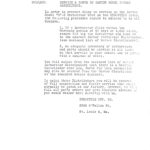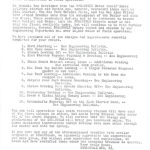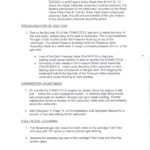DYNACYCLE SERVICE BULLETIN #1
CLUTCH DISASSEMBLY
1. If for any reason the Clutch has to be disassembled, use the following procedure:
a. Remove the Allen Screw Plug in the end of the crankshaft.
Some crankshafts have Welch Plugs. Do not remove.
b. Remove the Allen Set Screw between the teeth of the Kick Starter Gear.
c. Kick Starter Gear is left-hand thread. Use soft metal rod to loosen the Gear with a smart blow between the teeth. (Clockwise motion)
d. Remove the Driving Disc Plate using soft metal rod in the Spanner Wrench hole and loosen Disc with a smart blow. (Counterclockwise motion)
e. Remove Thrush Washers and Bearings.
f. Clutch Drum can then be pulled off the crankshaft.
(Place pan under Clutch Drum to catch transmission oil)
DYNACYCLE MISFIRING OR SHORTING OUT
1. If Dynacycle refuses to start or is misfiring, (after checking Sparking, Spark Plug and carburetion), there is a possibility of a short in the Magneto pigtail wire which connects the Condenser and Breaker Points. If this wire is loose, the flywheel may rub off the wire insulation and cause a short at the flywheel. To check this, remove the Gas Tank and make sure the pigtail is not rubbing against the flywheel causing a short or a ground. If so, position the pigtail wire away from the flywheel and tighten nut.
CHAIN ALIGNMENT
1. If chain runs too close to the Gear Housing Cover (Installation Manual, Fig. VII), the rear wheel may be shifted to the right by adding one or two washers to the left-handed side of rear hub. (Install between 2 serrated washers, see Manual, Fig.1).
MUFFLER
1. If Muffler vibrates loose from the Muffler cap end (front), tighten nut in the end of the Muffler. (This also has a locknut). Note: This nut is on the end of a tie-rod, which pulls the Muffler up into the Muffler cap.
KICK STARTER SHAFT
1. Periodically check then Kick Starter shaft screw #6 (Manual Fig. IV) for tightness. This screw must be kept tight at all times to insure proper Kick Starter action. Likewise, the Shaft will wear the Transmission Plate hole larger, and develop play in the Kick Starter.
DYNACYCLE MFG. CO.
St. Louis, Mo., U.S.A.
DYNACYCLE SERVICE BULLETIN #2
MAGNETO….POINT SETTING…TIMING LOCATION
a. Remove gas tank
b. Remove flywheel*
c. With breaker point follower resting on high side of the cam, adjust breaker point lock screws until a clearance of 0.018” is reached.
*Note: (When replacing flywheel, flywheel nut should be
tightened extremely tight. Looseness of the flywheel
nut can shear the crankshaft key and cause serious
damage to the crankshaft).
2. Timing Location: (Refer to Fig.III, page 4, of the Installation and Operation Manual).
Note: (Fig.II is used for reference only. The Magneto is not
shown in this picture.)
Turn the Magneto Stator Plate or Mounting Plate until
the Magneto Coil is on top. (You must first loosen the
Stator Plate set screw on the right- side of the Stator
Plate.)
a. Align the top right-hand corner of the Magneto Coil with the right-hand side of the No. 2 cap screw (Fig II). This is the best timing location. All DYNACYCLE engines leave the factory with this timing location.
b. Lock Magneto Stator Plate to the crankcase by tightening the set screw. From this location you can then:
(1) Retard spark (to prevent kicking) by loosening Stator Plate set screw and moving Stator Plate clockwise (not over 1/4 inch).
(2) Advance spark by loosening set screw and moving Stator Plate counterclockwise (not over 1/4 inch)
SPARK PLUG
1. Proper electrode gap on the spark plug is 0.025 inch.
ENGINE LOSS OF POWER…PISTON RINGS AND REED VALVE
1. Gradual loss of power or compression may be due to worn or stuck piston rings. All 2-cycle engines will show rather heavy ring wear. Rings are cheap and should be changed if loss of power develops. Carbon should be cleaned from the exhaust ports in the cylinder block at the same time. (Note: Carbon can be cleaned from the exhaust ports without removing the cylinder head. See page 16 of the Installation and Operation manual).
2. Sudden loss of power or compression may be due to a fractured or split Poppet Valve Reed (Part #1101-E). To check this Reed Valve the carburetor must be removed. It is located just forward of the carburetor, mounted on the Reed Valve Plate (Part # 1104-B). If the Reed Valve is fractured, causing a leak, this will prevent transfer of the gas mixture to the combustion chamber above the piston.
PRESSURIZATION OF GAS TANK
1. Due to the fact that 1/2 of the DYNACYCLE gas tank is below the level of the carburetor, pressurizing of the tank is necessary. This is accomplished through a Disk located under the Pressure Bushing on top of the crankcase. This same Pressure Bushing holds the Pressure Valve Assembly which is a relief valve to keep a constant pressure of 4 oz. in the gas tank.
a. Loss of the Disk Pressure Valve (Part #1418) or improper seating could cause inability to start or operate the DYNACYCLE.
b. Immobility of the needle in the Pressure Relief Valve Assembly (Part #14004-A) could cause flooding of the carburetor or hard starting due to lack of pressure in the gas tank. Dirt clogging the small vent hole in the top-side of the Pressure Valve Assembly could also cause flooding or hard starting.
CARBURETOR ADJUSTMENT
1. Do not idle the DYNACYCLE engine too slowly. Allow the engine to idle just below the clutch engagement point. A relatively high idling speed will compensate for weather changes and give easier starting. Throttle Adjustment Screw is located on the carburetor cable lever arm immediately above the carburetor.
2. See Paragraph 4, Page 14, of the Installation and Operation Manual for a too-rich or too-lean setting of the carburetor.
FUEL FILTER---CLEANING
1. Pull Neoprene gas line loose from both ends of the cartridge Fuel Filter and plug with 1/4” screw or rivet to prevent gas leaking.
2. Unscrew the serrated cap end of the cartridge Filter body and blow the screen clean.
3. When re-installing the Filter in the gas line, make sure that the Serrated cap end and attaches to the carburetor line, not the gas tank line.
BEARING INSTALLATION
1. All needle (roller) and ball bearings must be pressed in with extreme care. Needle bearings should only be pressed into their cavities with the imprinted or lettered side toward the pressing block or some other hard material.
2. Pack loose needles in the large end of the connecting rod with grease before installing (14 needles in the cap, 14 needles in the rod).
3. Large Main Crank Bearing (Part #1205) should be installed so that the Ball Bearing Retainer (thrust Bearing) operates on the smooth, or non-imprinted side of the Main Crank Bearing. (Note: This is just the reverse of pressing in the needle bearings).







